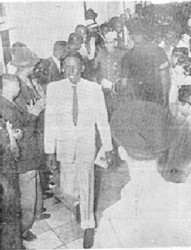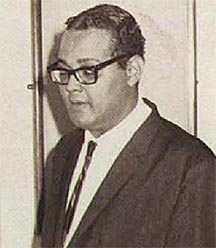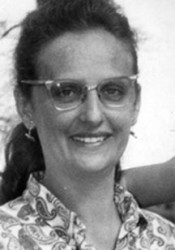This is the second instalment of Eusi Kwayana’s reflections on the events of 1953 culminating in the suspension of the constitution by the British government
By Eusi Kwayana
The election victory of the PPP in 1953 has been both overrated and underrated.
In the previous article I referred to the supporting voters as a critical mass. The ‘critical mass’ was of many ethnic and many class and income levels as well as occupational ones. To cope with an unknown future we need to revisit our positions and reaffirm or modify them if necessary.
Under the first-past-the-post constituency system of 1953, it was a sweeping victory that took 18 of the 24 constituencies. Under the arithmetical PR system it would have not been the one-seat majority won by the combined opposition in 2014. The PPP share of the valid votes cast was 51 per cent and this was about 38 per cent of the total electorate. Perhaps this was a good measure, this 38 per cent of another important reality or ‘variable.’ And I have no statistics to offer.
Reflecting years later as a person involved on the significance of the 1953 vote for the PPP I had come to the conclusion that it was a vote of those throughout the country, members or non-members who shared two sentiments. One was the preference for a multi-racial national movement. The other was the need to restrain the power of the sugar interests and the Colonial Office, stronger in 1953 than it was in 1853.

(now Eusi Kwayana)
So the PPP victory in 1953 was equal to the one-seat majority of the combined opposition of 2011. The first past the post, horse race system favoured the PPP in 1953. Apart from that it was the fact that the PPP was a single unit, not something put together for general elections. Socially it was the only political organisation then that was present and active in all places and the towns at any given moment.
Somehow I remember writing a receipt for Phaige Mohamaed, a rice farmer near Kingelly and for Byron Lewis, an elder in Buxton where I lived, as a sample of its range on the East Coast of Demerara, where new things happened, after 1823.
Along with these, it was a full-time creature and not just a runner at election season.
Martin Carter, urban civil servant and poet, would spend a week of the August holiday understanding the issues of the small tenant rice farmers in a landlord estate at Devonshire Castle, carefully noting costs, routines, obligations and returns, as I would do with cane farmers on the East Coast. Boysie Ramkarran was another willing organiser bound by working hours at the Transport and Harbours Department, and family. This meant that we worked closely with Janet Jagan, the party’s secretary.

The present generation of readers deserves to have a sense of the public figures about 1953 to offset this over-playing of the Jagan family or the Burnhams. Jagan was the only legislator (1947) who attempted to transmit to the popular audiences some of the experience of the past. In a furious burst in the city he was explaining the contrived defeat of the Popular Party. He said that the progressive movement of those days had been defeated by the sugar producers and the Wight family, and then he added “these bitches.” Being a leading dentist, a legislator and a member of the Queenstown middle class, though dissenting, he lost no reputation on account of diction.
The individuals who ended up as MPs or ministers had come through different routes to ministries or seats in the parliament. Apart from Cheddi Jagan and Janet Jagan there were well-known persons active in some form of public life. On April 26, the day before the general elections, the Daily Argosy devoted its editorial to scaring the electors by painting several leaders in deep red. In the opinion of many, these attacks intended to scare, also advertised the movement as a force feared by the dominant classes. Many in the population were convinced that the time had come for such a movement. Many claim that it was the Enmore strike and the events creating the Enmore Martyrs that built the PPP. The shooting had brought a strong popular response, and observers and commentators said that Enmore made the PPP into the force that it was. Eyewitnesses would modify that statement; they would advise that Jagan, a young overseas educated Indian Guyanese had been elected to the Legislative Council in 1947 and almost alone from that forum had brought about a change in the country’s political conversation. Not all shootings of workers have led to important change movements. There had been a shooting of workers in 1939 at Leonora, a more significant social context than Enmore, where six workers were killed including an Indian woman and an African male.
By 1948 when Enmore happened, Leonora was not even a subject of popular reference on the East Coast. The more total and expanding influence of the events at Enmore were perhaps due to the post-war situation and temper, the location and developing network of solidarity by the small Political Affairs Committee (PAC), its relations to other trade unions and the new advocacy of Cheddi Jagan. Almost, but not quite faded too, were the traditions of the BG Labour Union and its still living dauntless pioneer Hubert Nathaniel Critchlow, the first documented and widely appreciated labour internationalist from Guyana.
The support base of the PPP was not contrived. The talents it attracted and assembled as members or supporters and advisers were responding to the revelation of a new political idea or doctrine in their innocence before it became intertwined with race, money, and other power determining factors.
What there was of a home developed culture and machinery of government was almost entirely the creation of the post-apprenticeship African, which left a structure resulting from interaction and conflict with the dominant powers. The spirit of the system was that no one should be left out. The attempt to introduce

denominational or missionary villages lost out to the Victoria model, which inspired all three types of villages that developed later. Judging from Dr Clem Seecharan’s 2014 lecture in Guyana Indians here for their part were achieving, even during indenture, in their new spaces a level of necessary cooperation and common action which was historic. These separate developments must have contributed in a major way to the evolving political culture in the British colony.
It was probably this deep yearning for equality, to be included, that formed the cultural and spiritual bond between descendants of the enslaved and the indentured and caused them to rally around the same promise and begin to trust it. The British had not caught on to the emerging of this trust. That is why as documents show they had not expected the PPP or any party to win a majority of seats. On the other hand this writer supported only by Martin Carter in the executive had urged that the party should not seek to win at that stage. The idea was for the trust to mature. The two leaders Jagan and Burnham had a single answer that carried the day: “If you’re fighting, you’re fighting to win.” That attitude was full of common, common sense and standard political wisdom. The drawback was applying this without sufficient reflection.
There was a new kind of tension, a tension not spoken of as politically important but in which both sides played a part. The Governor Sir Alfred Savage was “getting to know” the county as would be expected. He would then broadcast to the nation saying that he had visited and had “heard and seen their problems. But the ministers have all the power.”
The Patriotic Appeal
On the other side, and this is not recorded in the White Paper or in any official report, the BG Peace Committee launched a signature campaign to remove the obstructing power of the colonial officials in the day-to-day administration.
The reforms as I recall were wholly concerned with domestic issues and did not affect foreign policy. This statement is subject to verification from primary sources. It is too serious for me to expect the public to rely on my memory. I dare not try to recapture the detailed demands. The Appeal was intended to dramatise the traps in the constitution.
Was the signature campaign of September-October1953, the Patriotic Appeal, the straw that broke the camel’s back, or the last straw? Why is it not mentioned in The West On Trial or in the White Paper which was the official indictment, or in popular narratives? Was it because it laid bare the pretence of an advanced constitution that had been overplayed? This is a challenge to researchers and scholars. There was public excitement about the petition. Everyone wanted to sign it. In my ministerial office there was a special desk for signatures and long lines leading from the street. The newspapers could not have missed this spirited development. Hopefully efforts will be made to find and publish it.
Perhaps it contradicted too plainly the picture the accusers were painting. As one present and involved up to the teeth, officially listed as one of the 5 or 6 “ringleaders,” I declare that without an account of the Patriotic Appeal, its origins, its demands and the public response to it, the story of October 1953 is incomplete and manipulated.









